ABSTRACT
The aim of this article is to present the results and conclusions of research which focused on recommending an appropriate approach for the creation and maintenance of fish stocks in various types of water elements, from small ornamental pools to formal water elements and large close-to-nature fish ponds. These elements form part of cultural monument complexes and heritage protected settlements (especially historic gardens and chateau parks, religious complexes, village and urban heritage reserves). Detailed results are described of a two-year investigation of various types of water elements located in Kroměříž gardens, Červené Poříčí Chateau, and the former monastery in Osek, near Teplice, as examples of cultural monuments and their water elements. Issues of possible management of fish stocks, modifications of the aquatic environment to ensure stable conditions for fish farming, and the reduction of negative interaction of pollution and excessive or inappropriately chosen fish stocks and aesthetic perception of water elements are discussed. The results of the field investigations have shown an unsatisfactory state of virtually all locations due to water eutrophication, overgrowth of vegetation in some water elements, unregulated interventions in fish stocks, and uncontrolled fishing resulting in the reduction of predatory species population and the occurrence of invasive species. At the same time, a relatively low awareness of the possibilities of regulating fish stocks and of the principles of sustainable maintenance have been found.
INTRODUCTION
Leaving aside ancient civilisations and traditions, targeted breeding of animals and, in particular, fish in water elements in gardens has been documented since the Middle Ages. Fish tanks in gardens served not only to provide a ready-made stock of fresh meat for cooking but there are written reports preserved also mentioning the construction of fish-breeding reservoirs which are purely ornamental [1]. Parts of gardens were stone water tanks from which richly decorated pools and fountains of the Renaissance and Baroque eras originated. The existence of pools for fish and aquatic bird breeding is mentioned In some of our significant Baroque gardens, such as Ostrov nad Ohří, Květná zahrada (Flower garden) in Kroměříž, Libosad in Jičín, and Český Krumlov garden. Fish of natural colour were poorly visible in the water, so preference was given to the breeding of colourful forms, especially Prussian carp (or goldfish, Carassius auratus).
The breeding of certain species of fish and water birds has brought about increased demand for water purification and aeration. If an abundant water source was available in an elevated location where the flow-through system did not demand water pumping, i.e. it could be in operation continuously, there was no problem maintaining the desired water cleanness. It was then possible to breed birds and more demanding fish species, such as trout in the pool of Císařský mlýn in Prague under the reign of Rudolf II. If it was possible to turn on water elements, or their dynamic parts – such as water jets – for a limited time only, it was necessary to breed fish which were not so demanding with regard to the oxygen content in water, e.g. carp. So-called “Pstruží rybníky” (Trout ponds) in Kroměříž were stocked with carp because the water source for these ponds were wells from which water had to be pumped, so water jets were probably only in operation when visitors were in the garden. In large ponds in the garden, domestic fish species were certainly bred, but specific archival documents that have been preserved are only those referring to fish stocks for kitchen use. In the chateau park of Český Krumlov, during the 17th and the first half of the 18th centuries, carp breeding is documented in Velký zámecký rybník (Great chateau pond), which was supplied with water from an aqueduct that took water from the Polečnice river. There was a separate small reservoir (Pstruží rybník) established in the garden for trout breeding, which was supplied with colder and cleaner water from the nearby wood called Dubík.
It is evident from the aforementioned information that domestic fish species farming was probably quite common in the majority of all informally established water elements in landscape parks. From at least the 18th century, preference was given to colourfully distinctive fish species in regular pools. Breeding of domestic, especially nobler kinds of fish (e.g. trout species) was documented in these reservoirs from the 16th century. Fish stocks in water elements are connected in the modern era, i.e. from the 19th century, with the development of the ornamental fish sector.
The beginnings of ornamental (decorative, aquarium) fish breeding – i.e. breeding for non-consumable purposes – are usually associated with medieval China, where, after centuries of experiments, the so-called goldfish and its veiled form – the veiled fish – were bred from Carassius auratus [2]. The first records of their import into Europe are from the 17th century. It was not until the first half of the 18th century that the veiled fish became more widespread in Europe, when its reproduction was successful in the Netherlands (1728). From the 18th century, goldfish breeding became prestigious in royal houses, later they started to appear as decorations in noble mansions and bourgeois houses. These oldest aquarium specimens were imported into Europe, into Germany and subsequently also into Czech lands, in the 1870s and 1880s. At the time when goldfish breeding became a form of mass interior decoration, it started to be used similarly in the exterior – especially by the aristocracy in chateau garden ponds. In Western Europe, where it was more common, goldfish were also present in the wild where they escaped either from garden ponds or they were added there deliberately. Goldfish successfully interbred with Carassius carassius which was common in southern England, Scandinavia, and continental Europe in the area from the Rhine river towards the east. Carassius auratus and its forms were more suitable for the exterior, for ornamental ponds where they were bred similarly as tench and its colourful forms or Nishikigoi fish (Cyprinus carpio haematopterus) [3, 4]. Their breeding in our country at the turn of the 19th and 20th centuries was documented, among other things, by “the exhibition unique in the richness and variety of the exhibited live pond, river and ornamental fish[…], such which have never been seen in Czech exhibitions before” which took place on the initiative of the Agricultural Council in Prague in Kolín in 1908. Part of an extensive programme was also an exhibition of the aforementioned decorative fish breeding. During the 20th century, including the decades after 1989, breeding of other fish species and their ornamental forms were introduced, such as golden and blue orfe, various types of sturgeon and, in particular, various variants of “koi” carps [5].
Consumable fish breeding has a very special place in our history, and is closely connected with the centuries-old tradition of constructing artificial reservoirs (ponds) whose main – but not sole – purpose was to breed and produce fish. Pond management was one of the key forms of aristocratic entrepreneurship. Families who became especially famous for building extensive pond systems were the Pernštejn (Pardubice, Poděbrady, southern Moravia regions) and the Rožmberk (Třeboň region). The boom era for the fish trade occurred in the 15th and 16th centuries. The advantage of investing in pond management was related, among other things, to the discovery of three-stage carp farming (in fish fry ponds, fish juvenile ponds, and main ponds). From the Thirty Years’ War, and especially in the second half of the 18th century, there was a rapid reduction in pond water areas and also a decline in fish meat consumption. The economic potential of pond management of extensive fish farming faded away and prices of fish, especially of carp, stagnated due to overproduction. This manifested itself in lower investment in pond maintenance and related lower yields. More profitable sectors of food production came to the forefront (beer industry, grain, forage and, later, sugar beet growing, cattle breeding, etc.).
The decline of pond management and lower general interest in traditional kinds of fish as an integral part of inhabitants’ diets lasted till the middle of the 19th century. At the time of the culmination of the decline, the species diversity of pond fish changed. At the end of the 17th century and during the 18th century, the carp, which had had a dominant position among fish so far, gained strong rivals in the form of “secondary fish species”, such as tench, pike, crucian carp, perch, loach, pikeperch, burbot, trout, and also “white fish species”, especially roach and rudd. As they became more popular among consumers, they were stocked in ponds next to carps and pikes, and special-purpose breeding ponds started to be founded (trouts, pikes). Many carp ponds were converted into mixed ponds. The better quality of the predatory pikeperch of Eastern European origin led to it starting to be preferred to traditional pond pike breeding in many places (e.g. in southern Moravia), which continued throughout the whole of the 19th century until the original carp–pike link returned. At the beginning of the 19th century, carp, pike, and pikeperch were evaluated as the most important kinds of fish. In the meantime, the economic significance of tench as the main “secondary fish” at the expense of previously preferred crucian carp also grew. This development was documented in examples of Moravian pond management but it is applicable, with slight regional deviations, for the rest of the Czech lands too.
There was a turnaround in terms of pond management in the third quarter of the 19th century, when the process of pond cancellation culminated and when, at the same time, demand for fish meat increased, the price of which rose many times in the meantime. New circumstances forced owners of manors to use remaining areas more effectively and to slightly increase them. The return to profitability of the traditional industry was facilitated by structural changes in agricultural business, new trends in fish farming coming from Western Europe, and, above all, the recognition of the national economic importance of fishing, manifested, among other things, in the form of fishing laws (Reich 1885, Moravian 1895) and the establishment of branch associations. Carp breeding – as the key commodity of the Czech lands – was put on a scientific basis thanks to the efforts of Tomáš Dubisch in Těšín (chamber) ponds and Josef Šusta in southern Bohemia (Schwarzenberg) ponds [6]. Their innovative approaches, cultivation, and introduction of new species of fish (i.a., Theodor Mokrý bred a new species of mirror carp known as “modrák” – coloured in blue – at a manor in Lnáře), food care, and condition of ponds, as well as the recognition of patterns in the relationship between fish and their environment, significantly helped to improve the efficiency of fish production [7]. Their efforts represented a critical turning point in artificial breeding of freshwater fish, with international significance which achieved the organisation of pond management within the whole Central European territory. Further development of the production fish industry in the Czech lands has been already well documented and described in many publications by several authors (e.g. [8–10]).
The aim of this article is to present the results and conclusions of individual parts of the research which focused on recommending an appropriate approach for the creation and maintenance of fish stocks in various types of water elements, from small ornamental pools to formal water elements and large close-to-nature fish ponds. These elements form part of the areas of cultural monuments and heritage-protected settlements (especially historic gardens and parks of castles, monasteries, village and urban heritage reserves). The research took place between 2016 and 2019 as part of the DG16P02M032 project “Non-invasive and economical techniques of water elements environment quality and maintenance solution in the frame of historical monuments care” within the NAKI II programme of the Ministry of Culture [11].
METHODOLOGY
- The research sub-part was to contribute to answering the following questions:
- What is the current composition, quantity, and density of fish stocks in water elements of interest?
- How extensive is the presence of invasive fish species?
- Is it possible to improve the aquatic environment, stability of fish stocks and, in general, aesthetic perception of these water elements by modifications of fish stocks (reduction by hunting and adding predatory species)?
Based on the formulation of these research questions, the methodology of the research was prepared. This primarily involved the selection of suitable locations for detailed investigation and possible experimental work with fish stocks. The investigation team selected 18 national cultural monuments and heritage reserves, where the selection was based on previous knowledge. Survey investigations and visits to many these sites and reserves was between 2012 and 2014 [12], with detailed one-off research at about 60 locations from the list of national cultural monuments and heritage reservations carried out in 2016 [13]. Fish stocks of the water elements of these 18 locations were repeatedly examined and described in detail (observations, electrofishing, net fishing). Repeated investigations of the aquatic environment, i.e. point sampling of water, phytoplankton, phytobenthos and zooplankton, were also carried out to answer the research questions. Water elements at these locations represented practically all available types of formal and informal elements, including reservoirs used for commercial and sport breeding of market fish species. Fig. 1 shows an overview of the selected locations. Investigations and sampling were carried out on a monthly basis from March to November/December from 2017 to 2018. The aforementioned one-off research, carried out in 2016, took place during summer when the worst conditions can be expected in terms of oxygen balance and other manifestations of possible eutrophication.
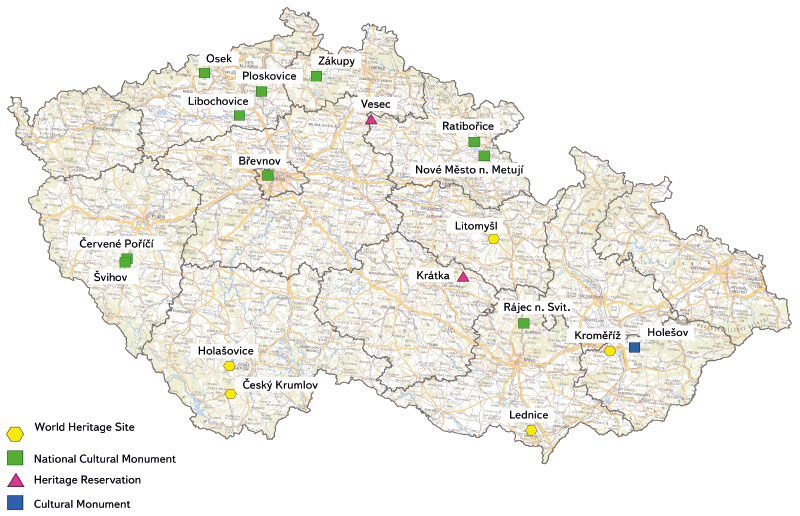
Fig. 1. Selected locations of detailed monitoring in 2017 and 2018
Repeated field investigations involved the measurement of physical-chemical characteristics of water directly in situ (Hach Lange Hq40d devices, telescopic water samplers and other aids, plankton nets, Secchi disk, aluminium geodetic levelling rod) and the aforementioned sampling. The samples were used in laboratories to determine, via standardised procedures, the composition of nutrients, organic substances, concentration of chlorophyll and pheopigments, as well as microbial indicators and trophic potential of water. Sampling and analysis of sediments was carried out once (organic content, microbial contamination). Apart from this, bioseston (kinds of phytoplankton), zooplankton, phytobenthos, and zoobenthos communities were analysed using standardised procedures.
RESULTS AND DISCUSSION
Investigation of fish stocks, in particular evaluation on the basis of fish harvest, was carried out during the first year (2017) in all selected locations where fish were reasonably expected. In the cases when monitoring with the use of electrofishing or net fishing was not possible or feasible (fountains, ornamental tanks), fish were registered only on the basis of observations. Of the selected locations, fish occurrence was confirmed in reservoirs of Kroměříž Chateau – reservoirs called “Přední Pstruží” and “Zadní Pstruží” in the Květná zahrada (Flower garden), and ponds – Dlouhý, Chotkův and Divoký rybník in the Podzámecká zahrada (Garden below the chateau), Lednice Chateau (ponds Růžový and Zámecký rybník in the chateau park), Ploskovice Chateau (pond in the chateau park), Červené Poříčí Chateau (pond in the chateau park), Rájec-Jestřebí Chateau (two ponds in the chateau park), in Litomyšl (“Pstruží” reservoir in the chateau park and ponds Hluboký and Růžový rybník within the local watercourse basin above the chateau), Holešov (reservoir in the chateau park), Osek Monastery (ponds within the monastery complex), Břevnov Monastery (reservoirs within the complex), Český Krumlov Chateau (reservoir in the chateau park), and in Holašovice village heritage reserve (village square pond).
In 2018, repeated investigations were carried out in locations which were selected as crucial at the beginning of the season for further evaluation of the impact of fish stocks on the quality of the environment in evaluated reservoirs. Monitoring via the use of electrofishing was carried out in reservoirs of Kroměříž Chateau (Divoký rybník – Wild pond), Lednice (Růžový and Zámecký rybník – Pink and Chateau pond), Ploskovice (pond in the chateau park), Červené Poříčí (pond in the chateau pond), Rájec-Jestřebí (both ponds in the chateau park, ornamental pool below the chateau), Litomyšl (“Pstruží” reservoir in the chateau park), Český Krumlov (reservoir in the park), monastery in Osek (reservoirs in the monastery park complex), and Holašovice village heritage reserve (village square pond). Monitoring of the stock during fish harvest was carried out in Dlouhý rybník – Long pond (Podzámecká zahrada – Garden below the chateau in Kroměříž). Fig. 2 documents the investigation of fish stocks in the field.
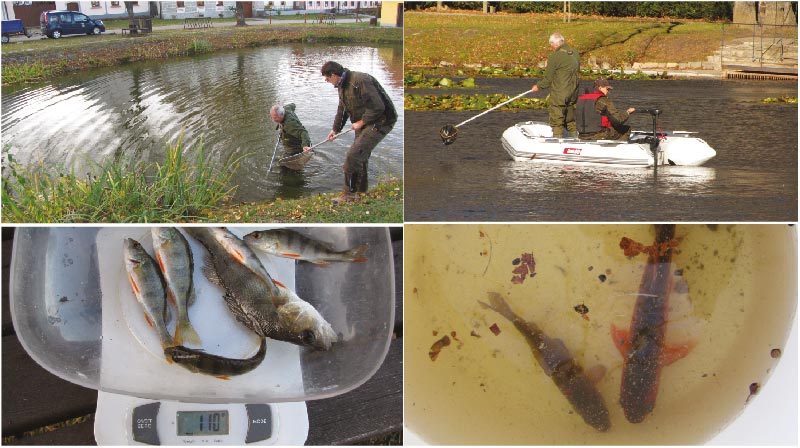
Fig. 2. Photo-documentation of fish stock during field investigations
Results of field investigations of the composition of fish stocks of water elements in sample locations
Based on the detailed results, we present examples of several locations with typical fish stock composition, standard care of them and, in general, typical characteristics of the aquatic environment and management of water elements. In the case of the water elements mentioned below in Podzámecká zahrada – Garden below the chateau, this was the state before extensive reconstruction, which included the cleaning and restoration of water element structures and associated channels in the garden in subsequent years.
Kroměříž – Květná zahrada (Flower garden)
In the complex of the Květná zahrada in Kroměříž, there are a lot of water elements out of which the most significant, in terms of their area, composition of the garden, as well as fish breeding, are two formal ornamental reservoirs, for the purpose of the project named as “Zadní Pstruží” and “Přední Pstruží” and a formal pool with an aviary called “Ptáčnice”.
State in 2017
- “Zadní Pstruží” reservoir
Seven specimens of the ornamental form of carp (Cyprinus carpio) “koi” with a unit weight of 1–2 kg were registered in this reservoir.
- “Přední Pstruží” reservoir
Several specimens of the ornamental form of “koi” carp with a unit weight of 1–2 kg were registered in this reservoir.
- Ptáčnice reservoir
Very shallow water level. Without fish. Frog tadpoles (registered on 10 May 2017) were abundant here. On 2 August 2017 new larvae were abundant and, during autumn sampling on 14 September 2017, adult newts were abundant.
State in 2018
- “Zadní Pstruží” reservoir
The presence of several specimens of the ornamental form of Prussian carp 1+ was registered in the reservoir.
- “Přední Pstruží” reservoir
The presence of several bigger specimens of the ornamental form of “koi” carp was registered in the reservoir. The reservoir became overgrown with submerged macrophytes (especially Persicaria amphibia) (Fig. 3).
- Ptáčnice reservoir
Very shallow water level. Without fish.

Fig. 3. Overgrowing of the “Přední Pstruží” reservoir with Amphibious Bistort (Persicaria amphibia)
Kroměříž Chateau – Podzámecká zahrada (Garden below the chateau)
State in 2017
- Dlouhý rybník (Long pond)
At the time of the research, the pond was fishery-managed as a breeding pond with supplemental feeding provided. Its stock was monitored during fish harvesting on 30 September 2017 (Tab. 1). Apart from the added common carp (Cyprinus carpio), grass carp (Ctenopharyngodon idella) and northern pike (Esox lucius), an abundant occurrence of common bleak (Alburnus alburnus) and common perch (Perca fluviatilis) was found, as well as an abundance of common bream (Abramis brama), ruffe (Gymnocephalus cernuus), common rudd (Scardinius erythrophthalmus), common roach (Rutilus rutilus), and Amur bitterling (Rhodeus sericeus). All these species of fish come from the supply source (Morava river), to a lesser extent from incomplete harvest in the last breeding season. A valuable finding was that the invasive topmouth gudgeon (Pseudorasbora parva) was completely absent from the pond in 2017, probably as a result of being eaten by a relatively abundant population of perch, for which it is the preferred prey [14]. Specimens of “koi” carp and goldfish are also present in the pond stock and after the fish harvest their numbers return to the pond. Carp added here have an extremely high mortality rate of 82.5% while the normal rate is 15–25% [9]. This high mortality rate is a result of unfavourable environmental conditions (heavy siltation with anaerobic mud from fallen leaves, Aphanizomenon flos-aquae in summer). The average unit gain of 1.45 kg is very favourable, although the feeding coefficient of the grains provided could not be evaluated as the supplemental feeding records were not entirely accurate.
Tab. 1. Fish stock (fish stocking and fishing out) of the Dlouhý and Chotkův rybník in 2017
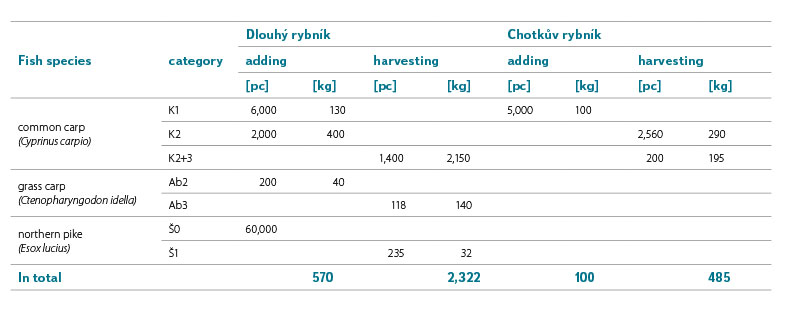
Tab. 2. Results of fish stock monitoring via the electrofishing (abundance of a and biomass of B in CPUE 1 hour) – Divoký rybník in the Podzámecká zahrada, Kroměříž
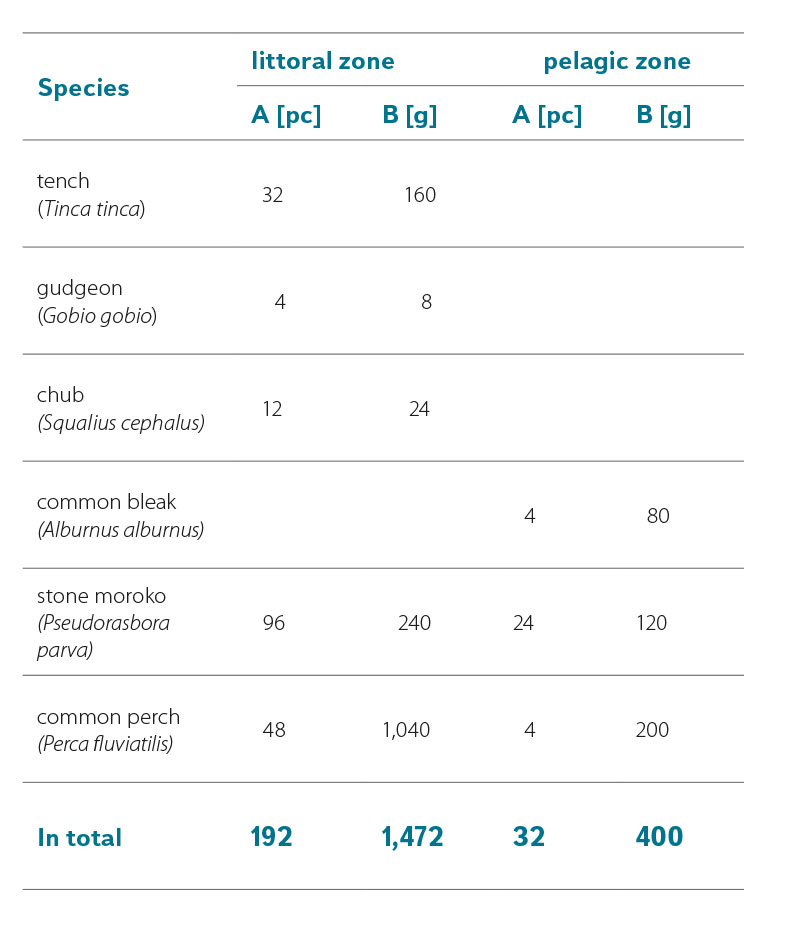
Tab. 3. Fish stock (fish adding and harvesting) of Dlouhý rybník in 2018
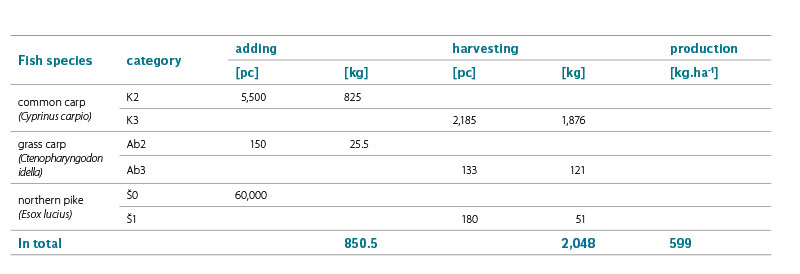
- Chotkův rybník (Chotek pond)
At the time of the research, the pond was fishery-managed as a breeding pond with supplemental feeding. In 2017 it was filled with water only in the middle of april. Part of the stock died out (according to the fish farmer statement and recorded presence of dead fish on 10 May 2017). This was caused mainly by unsatisfactory environmental conditions due to coverage of the entire water level with duckweeds. Its stock was monitored during fish harvest on 7 October 2017 (Tab. 1). During the harvest, the presence of topmouth gudgeon was noted; it was present despite an abundant occurrence of perch originating from the Morava river. Sporadically and probably from the same source, there was also pike, zander (Sander lucioperca), and bream.
- Divoký rybník (Wild pond)
In 2017, the pond was not fishery-managed due to difficult harvesting caused by the impossibility of emptying it completely. A large spill remains in the upper part of the pond above the island, which is very difficult to harvest due to the thick layer of mud. Stock monitoring was carried out on 7 October 2017 via electrofishing (Tab. 2) by wading in the littoral zone and from a boat in open water (both for 15 min). Apart from the fish stated in Tab. 4, there were also bigger specimens of carp registered that escaped from the narcotic electric field and therefore were not caught. Fish stocks are scarce and is mostly formed by juvenile specimens originating from the Morava river – gudgeon (Gobio gobio), common chub (Leuciscus cephalus),
Tab. 4. Results of fish stock monitoring via electrofishing (abundance A and biomass B in CPUE 1 hour) – Divoký rybník in Podzámecká zahrada, Kroměříž, 10 September 2018
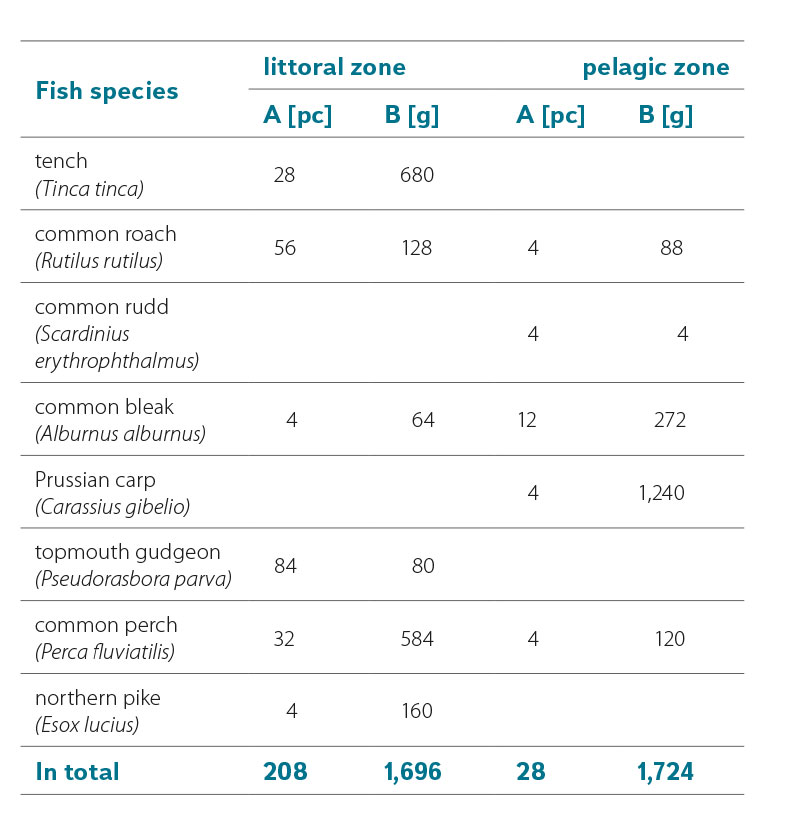
Tab. 5. Results of fish stock monitoring via electrofishing (abundance A and biomass B in CPUE 1 hour) – pond in the Červené Poříčí Chateau park
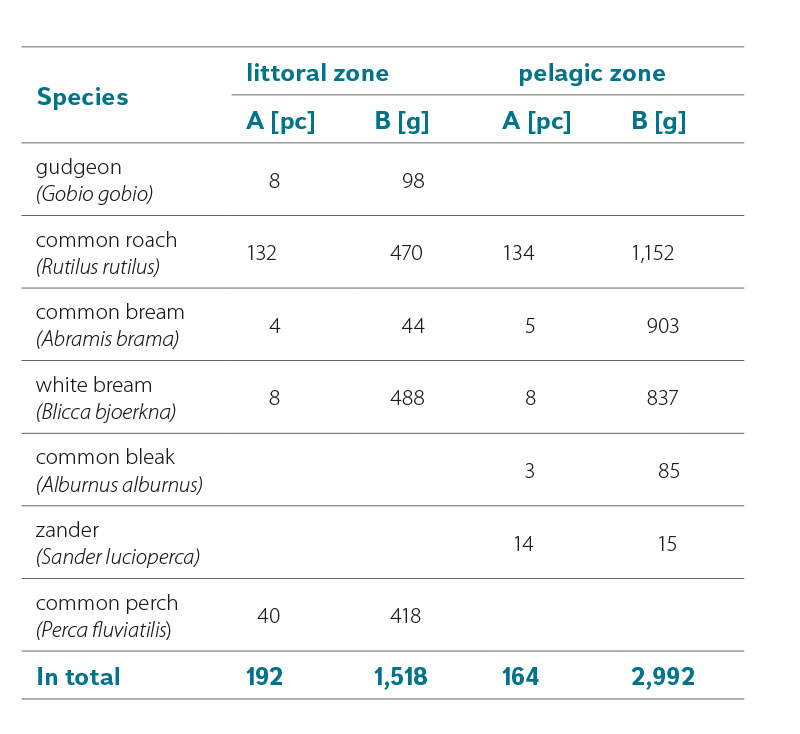
State in 2018
- Dlouhý rybník (Long pond)
The pond was fishery-managed, as in previous years, as a breeding pond with supplemental feeding (40 q grains). Its stocks were monitored during fish harvest on 29 September 2018 (Tab. 3). In May, part of the common carp stock died in the pond due to oxygen deficiency associated with a massive growth of filamentous algae, which the common carp and grass carp stocks were unable to control. Apart from the added common carp, grass carp, and northern pike, there was also an abundance of common bream, which formed about 70% of the fish, and common roach with about 30%, both species originating from the Morava river. Other fish species – common bleak and common perch – were caught only sporadically. As in 2017, the invasive topmouth gudgeon (Pseudorasbora parva) was completely absent from the pond, probably as a result of being eaten by a relatively abundant population of perch, for which it is the preferred prey [14]. Specimens of “koi” carp and goldfish are also present in the pond stock and after the fish harvest these are returned into the pond. In 2018, carp stock also had an extremely high mortality rate of 60.3% here (it was 82.5% in 2017) while the normal rate in our country is 15–25% [9]. The persistently high mortality is undoubtedly a consequence of poorly favourable environmental conditions due to heavy fouling by anaerobic mud from fallen leaves coupled with a strong spring filamentous algal bloom and subsequent high transparency (135 cm in May 2018) and oxygen deficiencies. However, the average unit gain of 0.71 kg and even 1.45 kg in 2017 is good, or very favourable, although the feed conversion ratio (FCR) either cannot be evaluated, because feeding records were not completely accurate (2017), or is relatively high (2.94 in 2018). In September, the occurrence of red-eared slider (Trachemys scripta elegans) was registered in the pond.
- Chotkův rybník (Chotek pond)
The pond was emptied in 2018 and prepared for desludging. This seemed to be urgently necessary with regard to the current situation, as the rate of pond overgrowth by hydrophilous vegetation had reached a level that completely excluded the possibility of refilling the pond without fatal consequences for its ecosystem.
- Divoký rybník (Wild pond)
Even in 2018 the pond was not fishery-managed due to difficult harvesting caused by the impossibility of emptying it completely. Stock monitoring was carried out on 10 September 2018 via electrofishing (Tab. 4) by wading in the littoral zone and from a boat in open water (both for 15 min). Apart from the undoubted occurrence of bigger fish originating from the stock that could have not been harvested in previous years, the current stock of Divoký rybník was largely formed of juvenile fish originating from the Morava river (bleak) and from natural pond spawn (perch, topmouth gudgeon, tench – Tinca tinca and roach).
Červené Poříčí Chateau
This location was selected as a representative of national cultural monuments which are based on immovable cultural monuments (usually royal settlements) associated with subsequent adjacent parts of the landscape with performed park modifications which usually contain various water elements. In this case, they are informal water elements such as ponds.
Tab. 6. Results of fish stock monitoring via electrofishing (abundance A and biomass B in CPUE 1 hour) – pond in the Červené Poříčí Chateau park
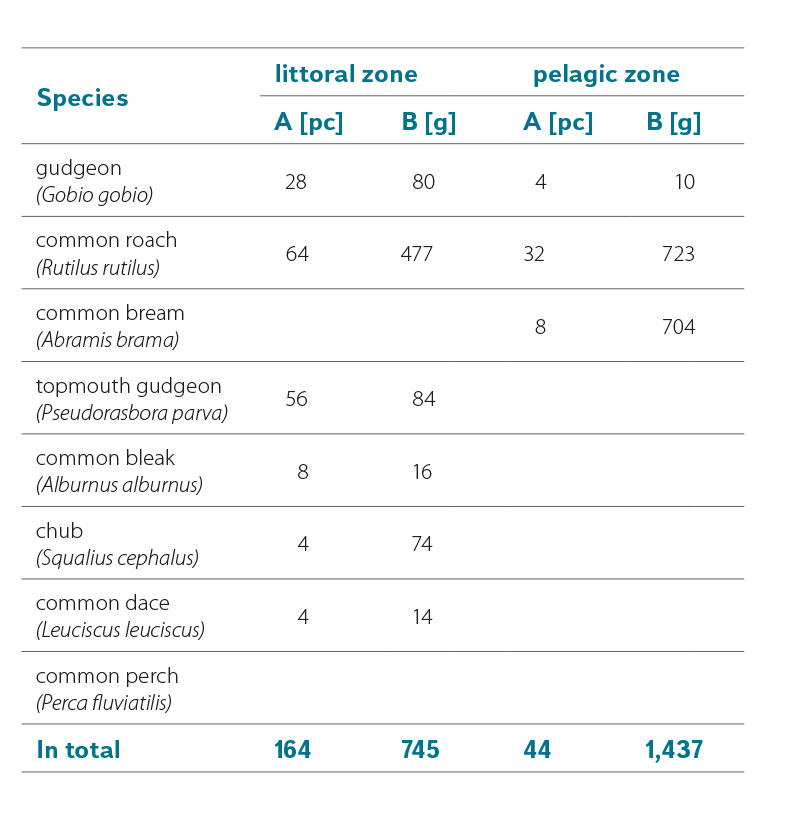
State in 2017
The pond in the chateau park is not fishery-managed. Ichthyofauna monitoring was carried out on 19 September 2017 via electrofishing by wading in the bank zone (littoral zone) for 15 minutes and from a boat on open water (pelagic zone) for 22 minutes. The results are summed up in Tab. 5. Contrary to other locations, white bream (Blicca bjoerkna) was captured here. Apart from the fish caught, a few pikeperches (~ 70 cm) and two pikes (~ 60 cm) were also registered here.
State in 2018
During this year’s investigations, traces of uncontrolled fishing were evident. It can be assumed that it aimed mainly at predatory fish. Ichthyofauna monitoring was carried out on 17 October 2018 via electrofishing by wading in the bank zone (littoral zone) and from a boat on open water (pelagic zone), both for 15 minutes. The results are summed up in Tab. 6. Most of the fish (especially gudgeon, common bream, common bleak, cub and common dace (Leuciscus leuciscus)) get into the pond through a tributary from the Úhlava river. In summer, a weak cyanobacterial bloom appeared on the pond and, in autumn, there was – as every year – an extremely strong silt from organic matter in the form of fallen leaves.
The complex of the former monastery in Osek in the Teplice region was selected and monitored as a representative of religious monument complexes which were, unlike the complex in Kroměříž, heavily devastated and at present are gradually being restored.
Monastery in Osek near Teplice
State in 2017
Reservoirs are not officially fishery-managed, and are stocked and harvested here by a private user according to a statement from the monastery fish administration. Fish stocks were monitored via electrofishing from a boat for 12 (reservoir I) and 22 minutes (reservoir IV) and via wading for 10 minutes (reservoirs II and III) on 20 September 2017.
- Reservoir I
An abundant stock of carp with an average unit weight of 1.4 kg was found in the reservoir, which caused strong turbidity on the bottom (transparency of only about 35 cm during the summer period). The occurrence of bigger grass carp was also registered here. The occurrence of tiny carp species – roach, rudd, and bream – was also abundant (Tab. 7). The reservoir stock was supplementally fed. The reservoir environment was degraded by the occurrence of cyanobacterial bloom in the summer period. In fact, the reservoir is an artificial water structure with inappropriately regulated – or rather unregulated – fish breeding.
Tab. 7. Results of fish stock monitoring by the electrofishing (abundance of A and biomass of B in CPUE 1 hour) – basins in the area of the Osek monastery
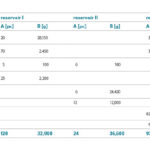
| Species | reservoir I | reservoir II | reservoir IV | |||
| A [pc] | B [g] | A [pc] | B [g] | A [pc] | B [g] | |
| common carp (Cyprinus carpio) | 20 | 28,150 | 3 | 2,672 | ||
| common roach (Rutilus rutilus) | 70 | 2,450 | 3 | 82 | ||
| common rudd (Scardinius erythrophthalmus) | 05 | 100 | 6 | 180 | ||
| common bream (Abramis brama) | 25 | 2,200 | ||||
| grass carp (Ctenopharyngodon idella) | 6 | 24,420 | ||||
| tench (Tinca tinca) | 12 | 12,000 | ||||
| Prussian carp (Carassius gibelio) | 82 | 1,445 | ||||
| perch (Perca fluviatilis) | 5 | 873 | ||||
| In total | 120 | 32,900 | 24 | 36,600 | 93 | 5,072 |
- Reservoir II
From the ecological and aesthetic points of view, the reservoir was in a state of disrepair, and from the point of view of fisheries management, it was unused and practically worthless (Fig. 5). More than 90% of its area was overgrown with hard emergent vegetation (Typha) and duckweeds (Lemnaceae). There was a thick layer of organic anaerobic sediments in the reservoir. During this year’s investigations, an attempt made by the local government to destroy the hard vegetation via adding grass carp was discovered. Unfortunately, this attempt proved to be ill-conceived and useless. The fish stocked (grass carp and tench) developed haemorrhages to the skin and scales (Fig. 5) shortly after being added due to unsuitable environmental conditions and with high probability subsequently died. Apart from them, a sporadic occurrence of rudd was also registered there (Tab. 7), which is able to survive such conditions but very probably not over the winter period of frozen weather.
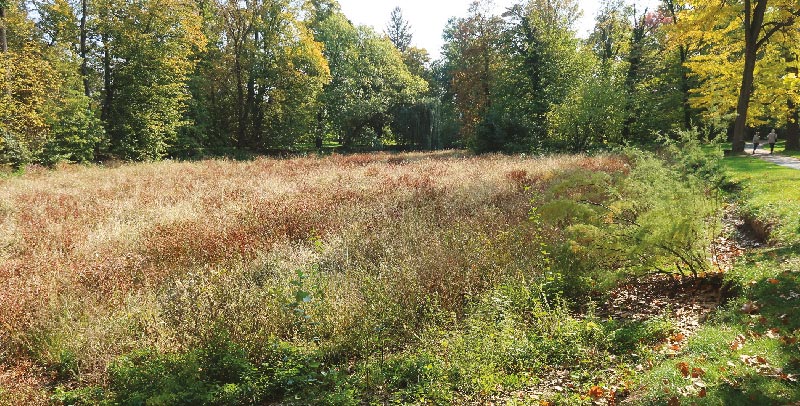
Fig. 4. Chotkův rybník after being emptied during the first vegetation season (2018)

Fig. 5. Osek II reservoir (left) completely overgrown with Typha and duckweed vegetation; grass carp (right) from Osek II reservoir with haemorrhages
- Reservoir III
From the ecological and aesthetic points of view, this reservoir was also in a state of disrepair and, from the point of view of fisheries management, it was unused. The reservoir environment was also degraded by thick layers of organic anaerobic sediments. Although there were several specimens of bigger fish (probably carps) clearly present in the reservoir which, when disturbed, whirled the sediments on the bottom, it was not possible to catch any of them via electrofishing. These kinds of fish probably will not be able to survive winter if the reservoir is frozen due to the shallow depth and thick layers of sediments.
- Reservoir IV
Abundant populations of Prussian carp were captured in the reservoir. Compared to the previous two reservoirs, this reservoir has favourable conditions for the survival of fish and for possible limited fishing use, targeted at the concept of the reservoir as part of the monastery complex (minimum sediment thickness, sufficient water level, relatively high quality aquatic environment without excessive phytoplankton, islands of wetland vegetation, flow rate). An overview of fish species caught is shown in Tab. 7.
State in 2018
In 2018, only Reservoir IV was monitored into which 6 pikes 2+ with a total weight of 5,700 g were added as a biomelioration measure on 6 April 2018. The objective of pike stocking was to reduce the overpopulation of Prussian carp. Fish stocks were monitored via electrofishing from a boat for 15 minutes on 17 October 2018 (Tab. 8). As stated above, the reservoir provides very favourable conditions for sustainable fish farming, which would correspond to the overall concept of the complex. However, at the time of the investigations, it was complicated by uncoordinated management in the case of which it was impossible to predict the interventions (stocking, harvesting, feeding, water level manipulation) that would be applied. During spring monitoring on 6 April 2018 an inadequately treated and secured outlet structure (monk outlet) was found to be leaking, which led to a drop in water level by about 50 cm compared to normal. Apart from fish species caught, the presence of rudd was also observed. Carp was the dominant stock of the reservoir, undoubtedly originating from adding. The occurrence of this year’s zander fry (0+) can be considered a valuable finding.
SUMMARY AND DISCUSSION
During field investigations and evaluation of the knowledge gained, four main factors have been identified which influence the determination of suitable fish, stocks and their long-term maintenance:
- input water quality supplying the given water elements and its eutrophication,
- temperature and oxygen conditions, changes in water pH,
- illegal fishing and uncontrolled hunting of fish, especially of predatory fish
- excessive siltation and organic matter supply (mainly fallen leaves) and its decomposition.
In order to design, implement, and maintain the target fish stock, it is necessary to investigate the aforementioned parameters and factors. Recommended procedures within routine care and maintenance, based on best practices, include measurements of transparency, pH, and water temperature, plus, for more detailed investigations, the use of field hydro-chemical devices to monitor seasonal fluctuations in water temperature, pH, and dissolved oxygen. The next step is the documentation of the current state of the fish stock using the aforementioned procedures.
Maintaining a fish stock in good condition, adequate quantity, and composition, including ornamental species, with regard to aesthetic impact and maintaining appropriate environmental quality, requires the reduction of undesirable (often also invasive) species (especially topmouth gudgeon, Prussian carp – natural form) by harvesting or adding predatory species (most often pike, zander, perch) which, however, require higher-quality conditions of the aquatic environment. Under optimal conditions, similar interventions have proven to have a favourable impact. For example, the combination of electrofishing and the addition of perch in the water area in Holašovice village heritage reserve led to a complete reduction in the population of Prussian carp, which were abundant here (in 2017 there were 64 Prussian carp and rudd confirmed, reproducing in an uncontrolled manner, and when 32 perch were added in 2018, there were 24 rudd and no Prussian carp specimens found). The reduction of undesirable species also occurred in Reservoir IV of the monastery in Osek near Teplice, where the use of pike fry was tested.
Even in the case of stocking only ornamental forms of Prussian carp, adding perch proved to have a beneficial effect on preventing uncontrolled reproduction associated with the appearance of a wild form, which no longer meets the aesthetic perception of the water element. It was demonstrated within the research project in the case of semi-operation of model ornamental reservoirs during their maintenance and monitoring. In 2018, without the presence of perch specimens, 20 added specimens of ornamental form reproduced with a resulting number of approximately 100 specimens with colouration ranging from ornamental to natural forms. In 2019, new Prussian carp fry were eliminated thanks to the presence of the perch. The amount of fish remained at the stocking level.
Tab. 8. Results of fish stock monitoring via electrofishing (abundance A and biomass B in CPUE 1 hour) – reservoir IV
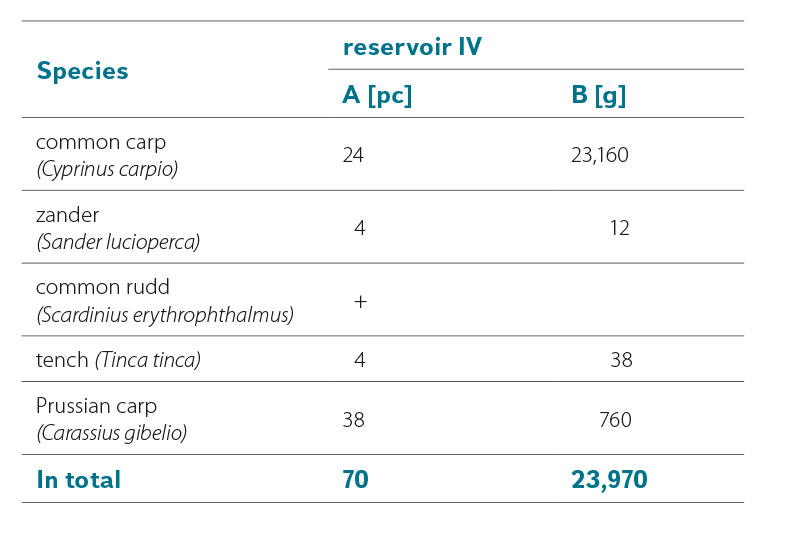
In the case of larger water areas with a production fishing function, it is necessary to choose such a composition and volume of fish stocking so that the recommended values stated in the heritage protection guideline are not exceeded. In contrast, it seems to be inappropriate to exclude farming use since the intended improvement in the quality of aquatic environment will not occur in the short term due to the eutrophication of our water bodies and spontaneous invasion by undesirable species. In contrast, the result is massive expansion of algal blooms (cyanobacteria) associated with health risks and reduced food supply for target fish and water birds.
The use of fish stocks to control the growth of aquatic vegetation, including algae, is, according to practical verification, possible, but it also requires the synergy of human labour, continuous removal of excessive biomass, supportive interventions (e.g. with gentle biological preparations, phosphorus precipitation), and ideally also limitation eutrophication of the input water. Early addition of suitable species (especially grass carp and common nase – Chondrostoma nasus) at the beginning of the season seems to be the most appropriate, but only after the biomass of the vegetation has been reduced to a level that can be controlled by the fish.
Fish breeding and the selection of suitable species for water elements is always closely linked to water quality, or the condition and quality of the entire water environment, including its interaction with the source basin of water elements, pools, ponds, and reservoirs. The environmental quality of water elements thus logically also has an impact on the condition and cultural value of monuments and historic heritage protected areas. The evolution of water quality and the qualitative (species composition) and quantitative (density and biomass) composition of fish stocks are closely connected. The effort to positively influence ecological processes and water quality in ponds and reservoirs through interventions in the fish community (stocking) is the subject of purposeful fisheries management. The purposeful management of fish stocking, whose main goal is to reduce the expansion of planktonic algae, is referred to as biomanipulation [15]. Biomanipulation therefore represents targeted influencing of lower links of the food chain by acting on fish as a hierarchically higher link of the food chain.
The fact that fish stock is able to control the species and size composition of zooplankton and phytoplankton communities and their abundance was first discovered by Hrbáček [16]. Subsequently, from the 1970s to 1990s, the manipulation of fish stocks and its impact on the structure and functioning of aquatic ecosystems became the subject of a number of scientific studies. The intensity of the research on this topic was motivated by the practical effort to reduce the effects of anthropogenic eutrophication (undesirable expansion of planktonic algae and cyanobacteria caused by excess nutrients in the environment as a result of human activities). At this time, the methodological guideline “Účelové rybí obsádky v údolních nádržích” (Purposeful fish stocking in valley reservoirs) [17] was also published, which provides an overview of the importance, creation, and use of regulated fish stocking in reservoirs. Later research has corrected some of the earlier views and, in particular, has better and more precisely defined the conditions under which biomanipulation is most effective. The up-to-date synthesis of the biomanipulation topic can be found, for example, in the works of Hansson et al. [18], Mehner et al. [19, 20], and Randák et al. [21].
Degradation of water elements is usually caused by:
- excessive fish stocks,
- unsuitable composition of a fish stock and fisheries management,
- uncontrolled development,
- inappropriate conditions – overgrowing, turbidity, pollution.
Some of the causes cannot be influenced by the location (water element) manager. In particular, these include aquatic environment quality:
- high temperatures of the environment connected with a rise in water temperature above a level that is bearable for fish (depending on the species, their limit level should not be exceeded) – drought periods are also a threat,
- insufficient water exchange, excessive evaporation – may be associated with an increase in salinity and electrical conductivity of water,
- poor water quality, polluted water, overabundance of nutrients in water (eutrophication), water especially rich in phosphorus,
- siltation caused by,
-
- washout caused by soil erosion, brought by a supply watercourse in the basin,
- biomass deposit from aquatic plants and fallen leaves,
- introduction of other organic components and creation of mud (also from excessive feeding).
-
The consequence of poor water quality is the massive growth of algae and cyanobacteria, their dying and the disruption of the oxygen regime up to the oxygen in the water being depleted. The consequence of siltation is the reduction of the water column depth and water volume, overgrowth with aquatic plants up to the gradual clogging of the water element, decomposition of the organic component of the sediment/mud – also connected with the depletion of oxygen in the water – and the emission of harmful gases (up to the stage of hydrogen sulphide odour).
Causes connected with incorrect fisheries management:
- incorrect determination of the size and weight of the fish stock,
- inappropriate composition of fish stock,
- exclusion of the farming use of fish stock, which leads, according to experience, to the spread of inferior and invasive fish species,
- shortage of predatory fish species or their uncontrolled illegal fishing, excessive feeding and supplemental feeding,
- inappropriate interventions into the environment, e.g. completely undesirable or incorrectly determined application of chemical substances in an attempt to ensure water transparency and algae suppression,
- incorrect manipulation of water volume and depth,
- damaged inlet or outlet structures, draining an inappropriate water level from the reservoir.
These causes, designated as internal, can be influenced by modifying the way the water elements are maintained, adjusting the lease agreement with the management entity, increased checking of water elements, etc.
CONCLUSION
Fish stocking is a natural and integral part of aquatic ecosystems and, therefore, plays an important role in the functioning of food relations and thus in the development of environmental conditions. In general, in reservoirs with a high biomass of planktonophagous fish (mostly tiny carp species) the zooplankton is formed by small species and low biomass specimens and the phytoplankton is well expanded (low transparency). In contrast, when there is low biomass ichthyofauna in the reservoir, the zooplankton is dominated by large filter-feeding daphnia, the phytoplankton is very poor, and transparency is high.
In water elements that are part of heritage protected structures, their gardens, courtyards, etc., the role of fish is often underestimated and the water quality in them is often degraded by inappropriate fish breeding, often even illegal or uncontrolled. They are also often colonised by unwanted invasive (topmouth gudgeon, Prussian carp) or non-native fish species (grass carp) that have a negative impact on the environmental conditions in them. The inappropriate composition and quantity of fish stocking leads to unfavourable quality of the aquatic environment, and formation of turbidity connected with the emission of nutrients used by cyanobacteria and other algae.
The formation of fish stocking in cultural monument complexes should be aimed at creating such a state that the fish stocking will not have a significant negative impact on water quality. In practice, this means creating, with regard to specific conditions of individual structures, prerequisites for achieving the preferred state which may consist, for example, of ensuring good water transparency (“cleanness”), adequate development of submerged and emerged vegetation, or the presence of ornamental (colourful) forms of fish. It is very likely though that their combination will also be desired (reservoir with clean water, plants, and ornamental fish).
As a result of addressing the issues described within the project, a peer-reviewed heritage protection guideline “Zásady udržitelnosti rybí obsádky vodních prvků kulturních památek a historických sídel” (Principles of sustainability of fish stocking in water elements of cultural monuments and historical settlements) [22] was also approved by the Ministry of Culture for use in practice. The guidelines are available within the web presentation of the project under TGM WRI HEIS [11] and in the NUŠL (National Repository of Grey Literature) database at (http://www.nusl.cz/ntk/nusl-411067). The guidelines concerning the principles of design, maintenance, and sustainability of fish stocking are closely linked to evaluation of the extent and causes of environmental degradation of the reservoirs and ponds of heritage protected sites, since the degree of degradation and limiting conditions caused by external influences determines the potential for sustainability of both the environment and fish stocking.
Acknowledgements
This paper was prepared with the financial support of the DG16P02M032 project “Non-invasive and economical techniques of water elements environment quality and maintenance solution in the frame of historical monuments care” of the NAKI II programme of the Ministry of Culture.
This paper has been peer-reviewed.
